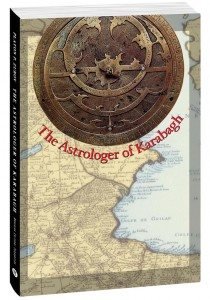By Platon P. Zubov
Edited with Introduction and Annotations by Ara Ghazarians
Reviewed By Murad A. Meneshian
125 pp.; ISBN 0-9674621-5-0
The Armenian Cultural Association’s (ACF) English-translated publication of The Astrologer of Karabagh or the Establishment of the Fortress of Shushi 1752 is timely and significant to the political status of the Independent Republic of Nagorno-Karabagh.

Platon P. Zubov’s (1796-1857) novel, published in 1834, deals with a crucial period in the history of Karabagh Armenians. The author served in the Russian Army and spent 20 years in the Caucasus where he became familiar with the peoples and their customs. During the author’s military service in the Caucasus, Karabagh was an administrative region, established by the Persian Safavid dynasty, ruled by five houses of Armenian lords—or meliks, a title granted to them by the Persian Safavid kings. The meliks were descendents of Armenian princely families that were dispersed when the Armenian Bakraduni Kingdom fell to the Turks in the 11th century. Established in early 1600, the meliks developed the only socio-political institutions in early modern Armenian history. The Armenians of Karabagh enjoyed relative independence and extensive privileges granted by the Persian kings. The meliks lived in peaceful coexistence. They united to defend their territories against invading enemies and supported the Persian kings in their wars against the Ottoman invasions of Persia. The historical novel’s theme is the disintegration of the five melikdomes caused by disunity among the meliks, brought about by Melik Shahnazarian of Varanda.
The Astrologer of Karabagh, though a work of fiction, reflects the realities of a turbulent period in the Caucasus. The novel is centered on a love story replete with historical events. The disunity arises from Jamshid’s (Shahnazarian’s nephew) refusal to marry the daughter of the Melik of Talish (Melik Hovsep Beglarian). According to ancestral tradition, the two families had imposed a cradle oath on the infant girl to marry Jamshid when the two children became of age. Jamshid’s refusal stemmed from his secret marriage to a young girl during his stay with the Turkish Javanshir tribe, which lived in the plains of Karabagh and was headed by Panah Khan, who desired to dominate the meliks and become the ruler of Karabagh. Jamshid’s refusal offended the Melik of Talish and resulted in a war between the four meliks and Melik Shahnazarian. Panah Khan’s opportunity came when Melik Shahnazarian sought his assistance. Panah Khan convinced his ally to build a fortress in Shushi to establish a foothold in the heart of Karabagh and to achieve his goal of ruling the entire region. Together they defeated the four meliks; Panah Khan became the ruler of Karabagh and soon subjugated his ally. The political maneuverings, machinations, plots, assassinations, and exiles that Panah Khan employed are personified in the character of the astrologer, who through the treachery of his trade influences the events and sells his services to the highest bidder.
The only prior translation of Platon Zubov’s work was into Armenian by Raffi (Hagop Melik-Hagopian, 1835-88) who found the novel important and translated it in 1882 as a related work to his historical tome, Khamsayi Melikutiunnere (The Five Melikdomes)—a historical study of the Karabagh meliks and the events leading to their disintegration as a result of disunity. Raffi published his translation in Grigor Artsruni’s Mshak (Tiller) where Khamsayi Melikutiunnere had ended in late 1882. Raffi presented the readers with a novel that helped them more easily comprehend the tragic history of Karabagh.
The author of The Astrologer of Karabagh conveys the same message as Raffi’s central theme in his works—namely, that disunity and internal squabbles are destructive elements. He expresses this idea in the spoken words of the Melik of Talish: “We were all dumb enough not to interfere with the construction of the Shushi fortress, which gave him sway over Karabagh. And the reason for this is in our feuding. Had we been united like our forefathers under Shah Abbas, this Javanshir would never have aspired to rule over Karabagh. While we—five petty rulers, the last shoots of the illustrious Armenian kingdom—endlessly bicker, squabble, and fight over nonsense, every trivial thing. No wonder we eventually ended up having an alien sovereign.”
The Astrologer of Karabagh was translated from the original Russian edition by Artashes Emin. The translation was edited by Ara Ghazarian, the curator of the ACF in Arlington, Mass., who has included an informative introduction describing the history of the Karabagh melikdomes and Russia’s role in the Caucasus. Ghazarian has provided commendable and extensive annotations expanding on and elucidating the historical facts and customs.
Copies of The Astrologer of Karabagh ($18 plus $5 for mailing) are available through the ACF (781-646-03090; acf.hmh@verizon.net) and at major Armenian bookstores.



Be the first to comment